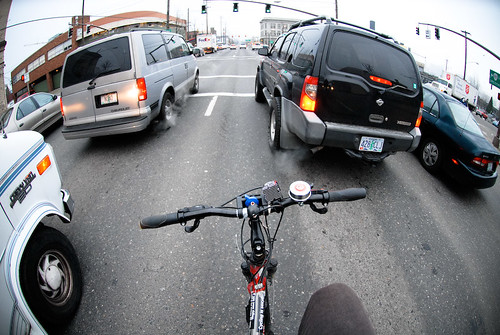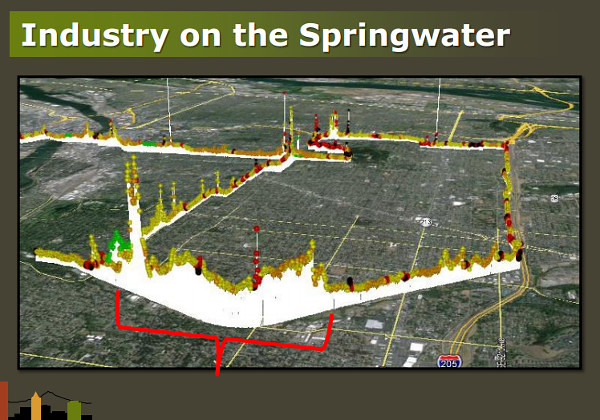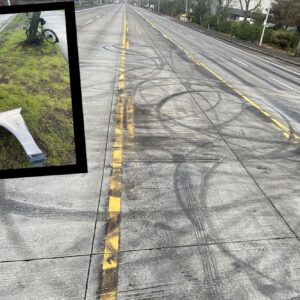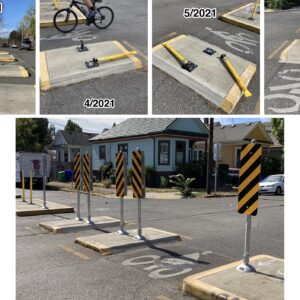
(Photo: J.Maus/BikePortland)
Last week’s news that a glass factory on SE 21st Street seems to have been emitting “alarming” levels of arsenic and cadmium has many Portlanders who bike through the area worried.
The recommendation for practice is to provide low-traffic routes wherever possible in bicycle networks, not to limit bicycle facilities on high-traffic streets.
After all, as we wrote in 2014, people biking ingest more pollution per second because they breathe harder.
But as it happens, the same Portlanders behind that 2014 study of biking and air pollution recently came out with a different finding: helping people avoid air pollution while they bike is one more reason to build a biking network.
As explored by Portland State University scholars Alex Bigazzi, Joe Broach and Jennifer Dill, it’s a simple concept, really: if you give people more routes to ride comfortably, they will be better able to avoid riding through pollution.
And indeed, the research team used Bigazzi’s self-made pollution-testing apparatus to determine that people do actually tend to better avoid pollution when they have good biking route options.
Compared to dose-minimizing behavior, bicyclists tend to use high-traffic streets too often if there is a bike lane and not enough if there is not. The recommendation for practice is to provide low-traffic routes wherever possible in bicycle networks, not to limit bicycle facilities on high-traffic streets.
Presumably, this is in part a response to one possible misinterpretation of Bigazzi’s prior research into air pollution. Bigazzi found, unsurprisingly, that streets with lots of cars have lots of air pollution. It’d be possible to conclude, from this, that it’s better to build bike networks away from large streets so people won’t be tempted to bike there.
But as Bigazzi has pointed out in previous research, proximity isn’t the only factor in pollution exposure. The other is time. If a direct route has slightly more pollution than a winding one, it might still be better for your lungs because you’re spending less time in the pollution.
Advertisement
This latest study brings some numerical heft to the discussion. When an interlacing network gives people a rich set of route options, they tend to be decent at choosing good ones.
Another thing to keep in mind here is the underlying fact of all health-related research on biking: The health costs of not biking are generally far larger than any health costs of biking.
This air pollution news from Southeast (and today’s follow-up about a second, smaller pollution hub just north of the Rose Quarter) is a useful reminder of another of Bigazzi’s findings from his previous study: cars are a big air-pollution problem, but they’re not the only one cities face.

Pollution is bad for everyone nearby, and a good bike network is no solution to the larger problem. But this paper is a useful reminder of the many ways that bike networks aren’t merely about appeasing an interest group or manipulating a behavioral shift. They’re about empowering people to help themselves.
— Michael Andersen, (503) 333-7824 – michael@bikeportland.org
BikePortland can’t survive without paid subscribers. Please sign up today.





Totally. I mean just look at China where there are far less cars and trucks aren’t even allowed in urban areas. Their air is like, crystal clear. Right?
It’s called industrialization at a massive scale…Thank your stars and stripes for the (Bush neutered) EPA, Scott.
Note: On the air pollution survey for the arsenic and Cadmium north of the Rose quarter. There is another art glass manufacturer located between Interstate and I5 one block north of Tillamook.
Ah, yes. Yet another reason to tell bicyclists to ride “a few blocks over”: less pollution! It’s for your own safety, ya know.
Not that anywhere in the U.S. will ever have a “complete” bike network—ever—but if it were to come true in some miraculous way, the miraculous cherry on top of the miracle would be to have direct routes that were pollution-minimized.
Actually, the researchers looked specifically at the air-quality tradeoffs in doing so. If you take a less polluted, but longer, route, you could encounter more pollution than a more polluted direct route.
I think the whole point of this study is that it shows the opposite of this, EB – see the paragraph before the ad, among other places.
I ride a few blocks over because I feel safer in general doing that, and because it’s not an inconvenience for me. But a secondary reason has been that the air is cleaner. Good to know that’s not just my hopeful perception.
The miraculous pollution-minimizer on direct routes is likely to be the electric vehicle. Which won’t make high-traffic arterials safer in terms of wrecks (unless all those cars are robots), or any nicer for someone like me to ride on. The reduction in pollution city wide, however, would (will?) be lovely.
Thanks to the way the Springwater Corridor is routed, a lot of us have a choice between car exhaust and Precision Castparts, ranked one of the worst industrial polluters in the entire country.
I think if you dig down on this company, you will see that all of the heavy metal emissions permitting are for other production sites far away in other states. They merged with another company a few years back which had all the EPA heavy metal permits. PC at JC uses some nasty acids and had a big acid cloud escape from their site a few years ago, but I don’t think JC site have the heavy metals air pollution issue that some of this company’s other sites have. Of course, these corporate production practices do change and evolve over time, so it is important to stay informed.
Interestingly enough I have applied, interviewed, and seriously been considered by every major polluter mentioned here plus others. I have also been rejected because of my expressed concern about the pollution levels in the last 20 years. My position would have been to make major reductions in the pollution and increased safety. None of my solutions were ever implemented.
I do not use the inner Springwater Corridor as a result.
The best places for business on the Fanno Creek Trail are at the places with street-front buildings (downtown Tigard).
Downtown Tigard, albeit tiny, is actually very multi-modal and intelligently-planned! The short stretch of Main Street has wide sidewalks, raised crosswalks, rapid-flash beacons as some crossings, a train station walkable from Main Street, and a nicely-paved bike path. Plus, the street itself is narrow, two-lane, and features curb bump-outs with bioswales. I definitely suggest checking it out! Plus, they have a nice brewpub and a hip coffee shop.
Interesting! Just last Saturday I took a nice long ride, but it went along some busy streets. I woke up the next morning with the same feeling I get when I’ve had too much beer and decide to bum a smoke off a friend. Now I know why. I wish we could ban public driving like we ban public smoking.
We need to get dirty diesel out of Oregon.
http://www.oregonlive.com/environment/index.ssf/2015/01/oregon_becomes_dumping_ground.html
“About 350,000 trucks in California are being phased out…”
“Newer trucks emit 90 percent less diesel soot, a known carcinogen. The U.S. Environmental Protection Agency estimates diesel pollution prematurely kills 460 Oregonians annually.”
“The arrival of California trucks undermines Oregon’s voluntary effort to get old rigs off the road. In the last 13 years, the Oregon Department of Environmental Quality has overseen the spending of $7 million, most of it federal grants, to retrofit, replace or retire 724 old diesel engines.
The state’s effort has reached less than a half-percent of the 145,000 older diesel trucks operating in Oregon.”
We’ve also become a dumping ground for old dirty diesel school buses.
http://www.oregonlive.com/environment/index.ssf/2015/02/oregon_schoolchildren_inhale_c.html
And then there’s Volkswagen et al.
http://www.nytimes.com/2016/02/08/business/international/no-matter-the-brand-europes-diesels-flunked-a-pollution-test.html?_r=0
I’d like to see the full pollution map, like were seeing the partial view on Springwater.
Yesterday, I chose to ride south home on N. Vancouver, instead of on N. Greeley. Not sure why, must have been the spring-like weather made me want to take the slow route. I had 3 unpleasant experiences on the one-way N. Vancouver: getting car horn blared at after momentarily taking 6″ of the lane to pass a slow moving cyclist; having a tri-met bus completely and without warning cut me off as it swerved into the bike lane; getting overcome with exhaust at a traffic light by a large diesel pickup truck idling next to me. Greeley has it’s problems, too, but my hope for a low stress ride home kind of faded, there.
For Portland, much of the pollution is concentrated in the central city, including Central Eastside from OMSI to Swan Island, and all of downtown. I guess choosing a street like Ankeny instead of Burnside, or Lincoln instead of Hawthorne to get from mid east side to central east side is the point of this article – to avoid sucking on long lines of tailpipes at traffic signals. But, at some point, you are going to be in the bad-air zone of central Portland.
Time spent huffing pollution on the bike while getting from point A to point B is a great metric: maybe we should use this in planning and building out new bike infrastructure. Can we build a fast, safe, and efficient bikeway without installing endless beg-buttons, special signals, stop signs, more traffic signals, left-turn bike boxes, routing through heavy pedestrian areas – one that allows the fast cyclists and the slow cyclists to both enjoy the path simultaneously, etc? I think this is a good challenge for PBOT.
To get maximum pollution while bike-riding, tailgate drivers while they are smoking with their windows down.
Gaahh, I do hate that! Double whammy.
Ride behind a 60s or early 70s vehicle in traffic. You must actually do it for full effect. Then imagine if lobbyists had prevented the govt from requiring cleaned up exhaust, and ALL CARS WERE SPEWING LEADED GAS ON YOU!
The best part of my commute is a one mile long section of trail, where i don’t have to breathe poisonous fumes.
It’s a strange mentality where the onus for the expectation to breathe clean air is on the people (“just wear a filtration mask”) and not the appliances (cars and trucks) that are expelling carcinogenic and otherwise toxic fumes into the public space.
That “strange mentality” is a symptom of our victim-blaming culture.